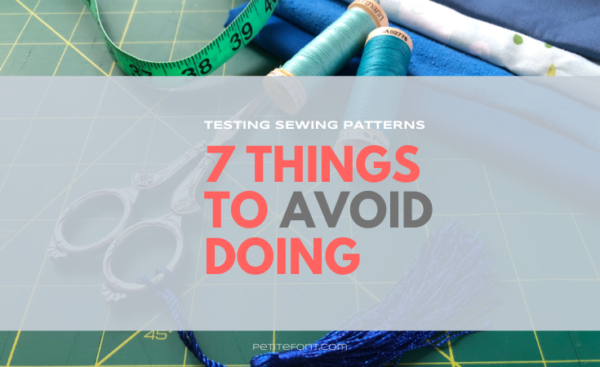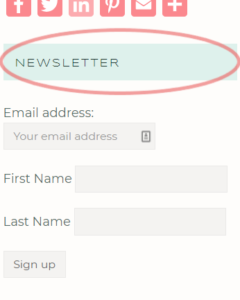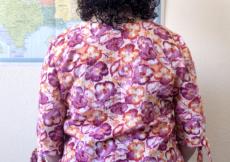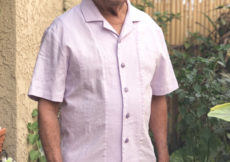 Here for the giveaway? Check out the details below and don’t forget to sign up for the newsletter for a chance to win!
Here for the giveaway? Check out the details below and don’t forget to sign up for the newsletter for a chance to win!
The very first pattern test I participated in was for The Wearable Studio. Is it a coincidence that they are today’s giveaway sponsor? Nope!
I learned a LOT testing for Mel, who is incredibly sweet and very easy to work with. You could say she spoiled us testers.
I’ve since learned that not all tests run like Mel’s. Sometimes the designer is absent, or doesn’t respond to questions, or doesn’t care about your input. This is less fun. But I’m not here to disparage other designers. I’m here to show you what NOT to do as a pattern tester.
What is a pattern test?
Here’s a quick and dirty description of the process. If you want a good in-depth explanation, my fellow House of Curves blogger Nikki has a whole series about it at Seams Like Style.
Pattern designers usually use a pool of makers to test a new design, at any step along the way of its creation. That might mean testing everything from the very first draft of a pattern to the very last finishing touches. Testers are not usually paid (though a few do have paid testers, and their requirements for joining their tester teams are usually MUCH more stringent than non-paid opportunities), but receive a free pattern (usually the one being tested) in exchange.
Testers use their own time and materials for testing, which means fabric AND paper for cutting out PDFs (yes these are usually indie PDF patterns).
A designer will set the timeline for the test, and will usually require photos of both a “fit” and a “final.” Pictures shot for “fit” are exactly what it sounds like: to assess if the garment is the right size, the design lines fall properly, etc. Consider it the muslin or toile for a garment.
“Final” pics are to ensure any adjustments made after the fit pics, and are sometimes used by the designer for marketing. You should be able to watermark them if that’s the case.
Of course, designers might have different or more requirements, good pictures usually being a key one.
How do I become a pattern tester?
It’s actually very easy! I’ve mostly seen tester calls in sewing groups on Facebook. Almost all indie designers have a support group for their patterns, but there are also general sewing groups that share this information. Check into these to find out who might be testing. If you sew, it’s a good idea to be social in these groups! You can see what others are making and also ask for help if you run into an issue with a pattern.
That said, there is still some etiquette to follow. Let me tell you what NOT to do!
Do NOT join a designer’s group just to become a pattern tester.
You should be somewhat familiar with a designer’s patterns before you jump in to test a new one. Know whether or not their patterns work for you (or whoever will serve as your model). I’m my own model since I don’t sew kids clothing, or find many tests for men’s patterns where I could use El Husbando for a model. And because I’m more inverted triangle (wider shoulders than hips), I don’t test for companies that design for pear-shaped ladies.
But also, the groups are social spaces. Join groups to connect with others in the same maker space. If/when a test comes up, the more engaged you are in a group, the more likely you are to even see the post!
Do NOT badger designers or their admin teams.
Just like you shouldn’t join a group just to test, you also shouldn’t immediately start reaching out to the design team to see if testing slots are open. Instead, you can search groups to see if the subject of pattern testing has been broached. There are also groups where open calls are posted and you can search them by designer, too. Engage in these discussions and see if the designer is actually one you do want to test for (there are also groups that act as Yelp for testers to find out about designer’s processes). Do not expect to be chosen the first time you apply either. Sometimes designers only need to fill a very specific size or niche that you don’t fall into, so keep that in mind.
Do NOT take crappy pictures of your makes.
One of the top things a designer is hoping for from a test is to SEE how the garment looks on their audience. If you take bad pictures, in low light, you are helping no one. Notice I didn’t say anything about what kind of camera to use. The tools you use are less important than HOW they are used. Photography literally means “writing with light.” So make sure your pictures are brightly (but evenly!) lit so a designer can see the details.
I take most of mine on my phone, outside, in open shade. I know at least a dozen bloggers who do the same.
Do NOT hide!
Speaking of blogging, it’s a good idea to have a social media presence that showcases your work. If you don’t blog, there’s Instagram. If you don’t do either, then hopefully you have posted pictures of your garments in Facebook groups. Most pattern testing applications require at least one photo showing a garment or a website where they can see multiple works.
Another option is to have a profile on sites like Pattern Review.
Do NOT share confidential information.
If you do not have EXPLICIT permission to share pictures, don’t leak images of a test in progress. There are intellectual property rights to consider, and designers usually choose the right day and time for THEM to release their patterns. Don’t jump ahead of the game and screw that up for them. It’s a one-way ticket to the Land of the Banned.
Do NOT flake.
Emergencies happen. But if you commit to a test, ensure you can hit all the necessary obligations. These should be spelled out clearly before a test starts, including the number of versions required and the time between start and finish. If none of this is spelled out, ASK. If you do find yourself unable to complete all the steps necessary, tell the designer or the test admin ASAP.
Do NOT take on more than you can handle.
Testing is a favor to the designer, but it’s usually also a critical part of their creative process. If you can’t give them what they need because you are too distracted by other obligations, do yourself a favor and don’t participate this time.
I’ve never participated in more than one test at a time, but I know some people can do that with complete ease. Know your limits!
***
And those were seven tips! If you’ve been a pattern tester, what are your tips for doing it right? Let us all know in the comments below!
If you want more fun on the topic, Bella Sunshine Designs has a whole slew of The Don’ts of Pattern Testing. It’s a cheeky little read, but gives you insight from the designer’s point of view!
So back to my wonderful testing experience with Mel and Wearable Patterns. I tested the Franki, which is adorable! The tie-cuff sleeves were my favorite part about the easy fitting top. It’s great for a variety of woven fabrics, and I’ve done it in both a floaty gauze and a washed silk.
Because of how much I enjoyed testing for Mel, I asked her if she would be open to donating a pattern for the giveaway—and she said yes! One lucky newsletter subscriber gets a chance to win a PDF copy of the pattern I tested: Franki! Though I made the 3/4 sleeve version, there’s also a short sleeve version with a different finish. It’s two patterns for one!
Even though it’s a PDF, you can also have it printed at a copy shop if you’re #teamnopdf.
Franki (named after Mel’s cute little pup) is also super ripe for hacking, and I have lots of ideas for it!
How do you win?
Simply sign up for the mailing list! One random winner will be chosen at noon PDT tomorrow. Need to know your time zone as it relates to Pacific Daylight Time? Check out the online Time Zone Converter.
The sooner you join the mailing list, the more opportunity you will have to win because there are still TWO more prizes to come AFTER this one! However, each reader may only win once. The final drawing will take place on Wednesday, October 31 at noon PDT. All winners will be notified by email and also announced on the Petite Font Facebook page and Instagram post.
Join or follow to see if you win!
The legal stuff:
No purchase is necessary to enter. Giveaway is open worldwide except where prohibited by law. Must be 18 to enter. Odds of winning are dependent on number of entries. One winner will be chosen randomly at noon PDT the day after a blog prize is published. Giveaway ends on October 31, 2018. Winners will be notified by email and winners’ names will be posted on Facebook and Instagram. Please be aware of time constraints on certain prizes to ensure timely redemption. Prizes will be awarded in the order listed. Prizes are all digital and will be distributed by email. Please direct questions to [email protected]. Giveaway is in no way sponsored, endorsed, administered by or associated with Facebook or Instagram, or any other platform used to promote this giveaway.
The value of each prize is as follows:
- $15 digital store credit to Wardrobe by Me pattern store (expires Oct 31, 2018) = $15 USD
- 1 digital PDF copy of the True Bias Lander shorts & pants pattern = $14 USD
- 1 digital PDF copy of the The Wearable Studio Franki top pattern = $14 AUD
- 1 digital PDF copy of any Itch to Stitch pattern = $0-15 USD
- 1 digital credit provided by Petite Font to the MyBodyModel custom croquis web app = $20 USD
Where is the newsletter signup?
If you dismissed the pop-up window, don’t worry! You can sign-up from two places: either here or the sidebar.
Need help finding it?
On the desktop site, it’s at the bottom of the sidebar on the right (under the social media share buttons). You might need to scroll up a little from here.
On mobile, it’ll be near the bottom of the page (just above the Instagram gallery in the footer).
Ready?








Great Info! Thanks!!
Ooo! Good article!!! Also, don’t change the pattern without clearing it with the designer first. Hacks are bad in tests, usually. LOL
Don’t make a garment with your preferred fit as opposed to the designers intended fit! I love slouchy but some designers over slouch plus size patterns for my comfort. I know this so when they put calls out I know not to apply because I won’t like the intended fit. Instead I wait until it’s released and make a garment I know I’ll wear and feel comfortable.
I never test patterns for garments that aren’t my style and look because most of the time you have to combine them with your wardrobe clothes for the photo shoot.
Don’t be afraid to ask questions! It’s okay to ask about something you’re not clear on, whether that’s what your requirements are as a tester, how to put something together or how something is supposed to fit. It helps the designer ensure that the pattern is the best it can be for their customers, who are going to have the same questions.
[…] not a bad pattern tester though. If I commit, then I follow through. And so when the opportunity came to test a new […]
All labor under capitalism is theft and exploitation, but free labor is slavery. Honestly, these companies are no better than large corporates, and arguably worse since they are paying NOTHING for your labor and expenses. It’s an unconscionable practice and should be abolished. They should be ashamed that they’re doing it, but hell they’re getting free labor, they don’t care. Pattern testers need a union, not free patterns.